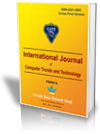Modification of Instruction Set Architecture in a UTeMRISCII Processor

Ahmad Jamal Salim, Nur Raihana Samsudin, Sani Irwan Md Salim , Soo Yew Guan"Modification of Instruction Set Architecture in a UTeMRISCII Processor "International Journal of Computer Trends and Technology (IJCTT),V4(5):1196-2001 May Issue 2013 .ISSN 2231-2803.www.ijcttjournal.org. Published by Seventh Sense Research Group.
Abstract: - The development of application specific instruction set processor (ASIP) is a methodology in designing the processor system. The designing of processor system is focused on the internal architecture of the processor. By using the ASIP design, it can offer the optimum performance and also the flexibility in a processor architecture, but with limited application. However, by implementing the processor on Field Programmable Gate Array (FPGA), it could further extend the opportunity to reconfigure the architecture instantly. Therefore, this paper is about the implementation of the modification of a 16-bit wide instruction set for a simple 8-bit soft-core RISC processor called UTeMRISCII. The purpose of the project is to improve the ability of the processor by adding a new instruction set that can be able to perform basic digital signal processing (DSP) algorithm. For verification, a multiply-accumulate (MAC) instruction is created as the new customized instruction. The modification of the instruction set architecture is achieved by using Hardware Description Language (HDL) implementation. To validate the operation of new customized instruction in the software platform, the CPUSim software is used as the simulator to observe the output. Meanwhile, in the hardware platform, the new customized instruction is translated into processor design and verified using the Xilinx ISE software. The Xilinx Virtex-6 board is used to implement the processor. The simulation and hardware synthesis results proved that the new MAC instruction implementation performed correctly and produces correct outputs during the processor execution.
References-
[1] J. Ball, "Designing Soft-Core Processors for FPGAs Processor Design," in Processor Design: System-on-Chip Computing for ASICs andFPGAs, J. Nurmi, Ed., 1st ed: Springer Netherlands, 2007, pp. 229-256.
[2] C. Galuzzi and K. Bertels, "The Instruction-Set Extension Problem: A Survey," ACM Trans. Reconfigurable Technol. Syst., vol. 4, pp. 1-28, 2011.
[3] L. Barthe, L. V. Cargnini, P. Benoit, and L. Torres, "The SecretBlaze: A Configurable and Cost-Effective Open-Source Soft-Core Processor," in IEEE International Symposium on Parallel and Distributed Processing Workshops and Phd Forum (IPDPSW), 2011, pp. 310 313.
[4] P. S. Mane, et al., "Implementation of RISC Processor on FPGA," in Industrial Technology, 2006. ICIT 2006. IEEE International Conference on, 2006, pp. 2096-2100.
[5] L. Barthe, et al., "The SecretBlaze: A Configurable and Cost-Effective Open-Source Soft-Core Processor," in IEEE International Symposium on Parallel and Distributed Processing Workshops and Phd Forum (IPDPSW), 2011, pp. 310-313.
[6] P. S. Mane, I. Gupta, and M. K. Vasantha, "Implementation of RISC Processor on FPGA," in IEEE International Conference on Industrial Technology 2006, pp. 2096-2100.
[7] J. S. Lee and M. H. Sunwoo, "Design of New DSP Instructions and Their Hardware Architecture for High-Speed FFT," The Journal of VLSI Signal Processing, vol. 33, pp. 247-254, 2003.
[8] W. Wenxiang, L. Ling, Z. Guangfei, L. Dong, and Q. Ji, "An Application Specific Instruction Set Processor optimized for FFT," in IEEE 54th International Midwest Symposium on Circuits and Systems (MWSCAS), 2011, pp. 1-4.
Keywords — ASIP; modification instruction set; Multiply-accumulate.


